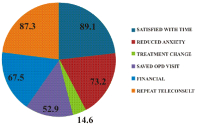Impact of telemedicine on healthcare delivery in gastrointestinal cancer patients during the COVID-19 pandemic https://doi.org/10.60787/NMJ-63-1-132
Main Article Content
Keywords
Cancer, COVID-19, Gastrointestinal, Pandemic, Telemedicine
Abstract
Background: COVID-19 pandemic necessitated changing the normal OPD practices due to lockdowns and the need to decrease the exposure of patients and health care, workers. Hence our institute adopted the telemedicine route to cater for patients. The impact of telemedicine on gastrointestinal cancer patients in Radiotherapy and Oncology OPD during the COVID-19 pandemic was analysed.
Methods: Retrospective data was extracted from the files of the patients who were seen through telemedicine. The time period for this study was kept from 1st September 2020 to 31st October 2020. Patients with only gastrointestinal malignancies were enrolled in the study. Patients were called telephonically to get their feedback on the telemedicine experience. Every patient completed a set of questionnaires. Physical OPDs were also running simultaneously with appointments made through telemedicine to reduce crowding and maintain social distancing.
Results: In total, data from 157 patients were obtained. Sixty-three per cent of the patients were from rural backgrounds,s while 37% had urban residences. The median age of the patients was 55 years (range, 13-80years). Thirty-eight per cent of patients had stage IV, 51.6% had stage III, and 8.9% had early-stage malignancies. Sixty per cent of the patients had either received or were on radical treatment, while 39.5% were taking palliative treatment. Approximately 53% of OPD visits could be avoided with telemedicine. Overall, the telemedicine experience received an encouraging response, with 87.3% of patients responding affirmatively to repeat the telemedicine if given the opportunity.
Conclusion: Telemedicine has led to uninterrupted delivery of cancer care, particularly for patients who were under active surveillance and lived in remote places from the hospital. Our study demonstrated patient and healthcare staff safety and the benefits of healthcare facilities to patients during this pandemic period. An assessment of the long-term impact on patient outcomes and healthcare systems needs to be done.


